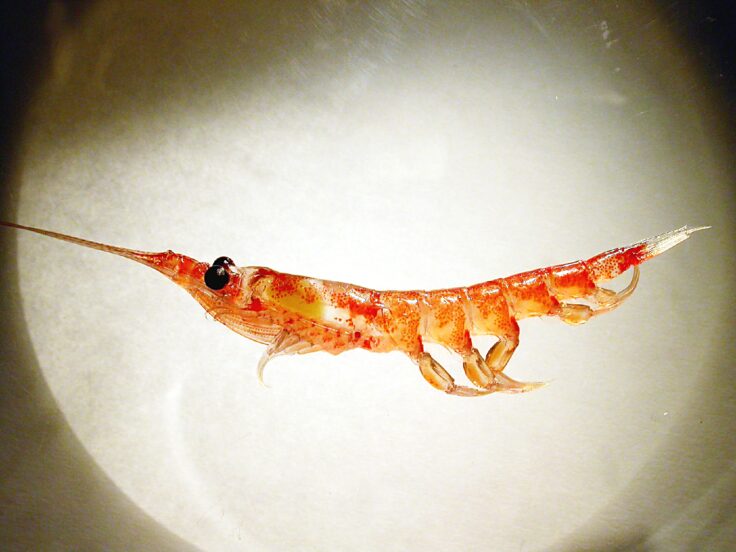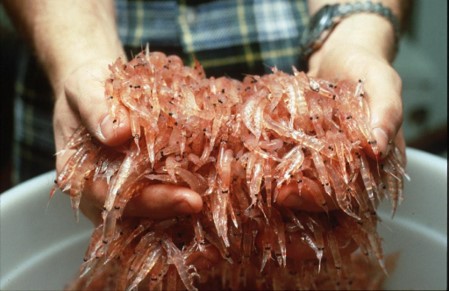A new study involving British Antarctic Survey researchers highlights the influence of krill (Euphausia superba) on atmospheric carbon levels. It is published in the journal Nature Communications today (18th October 2019).

Antarctic krill are well-known for their role at the base of the Southern Ocean food web, where they’re food for marine predators such as seals, penguins and whales. Less well-known is their importance to the ocean’s carbon sink, where CO2 is removed from the atmosphere during photosynthesis by phytoplankton and sequestered to the deep ocean as organic material sinks to the seafloor.
Lead author Dr Emma Cavan, at Imperial College London, worked with an international team to review current scientific knowledge of the role of krill in processes that each year remove up to 12 billion tonnes of carbon from Earth’s atmosphere.
“By eating phytoplankton and excreting carbon and nutrient-rich pellets that sink to the seafloor, Antarctic krill are an integral part of the carbon cycle and a key contributor of iron and other nutrients that fertilise the ocean,” Dr Cavan says.
Krill faecal pellets constitute the majority of sinking carbon particles that scientists have identified in both shallow and deep waters in the Southern Ocean. Antarctic krill can grow up to six centimetres long and weigh around one gram, but they swarm in such vast numbers that their combined contribution to the movement of ocean carbon and other nutrients can be huge.
The Southern Ocean is one of the largest carbon sinks globally, so krill have an important influence on atmospheric carbon levels and therefore the global climate.

Krill ecologist Professor Geraint Tarling at British Antarctic Survey says:
“Our research highlights a little considered role of Antarctic krill in the Southern Ocean ecosystem, how they counter CO2 emissions by moving carbon into the ocean’s interior. The fact that krill move round in vast swarms means that their carbon-rich faecal pellets sink on mass to the deep ocean, while their huge population biomass means that this happens on a massive scale. Management of the krill fishery needs to ensure that any impacts on this globally-important process are minimised”.
Management of the krill fishery in the region currently centres on sustainability and krill’s role in supporting predators such as whales, with little attention given to assessing the significance of krill to the carbon cycle and ocean chemistry.
Today the fishery takes less than 0.5 per cent of the available krill and only adults are targeted. But there is no consensus on the effect that harvesting Antarctic krill could have on atmospheric carbon and ocean chemistry nor how growing whale populations might also affect krill numbers.
Dr Cavan continues:
“Southern Ocean ecosystems and chemical processes are highly complex and poorly understood, and our lack of knowledge about the extent of krill’s ability to affect the carbon cycle is a concern, given that it is the region’s largest fishery.
“Our study has shown there is a pressing need for further research to address these and other questions about the significance of krill, as well as for more accurate estimates of their biomass and distribution. This information would inform both our understanding of biogeochemical processes in the ocean and the management of the krill fishing industry.”
Funded by The Pew Charitable Trusts, the research also includes scientists from the Australian Antarctic Division and research institutes and universities from the UK, Germany, and the US.
The importance of Antarctic krill in biogeochemical cycles Cavan, E. L.1*^, Belcher, A.2, Atkinson, A.3, Hill, S.L 2, Kawaguchi, S. 4, McCormack, S. 1,5, 3 Meyer, B.6,7,8, Nicol, S.1, Ratnarajah, L.9, Schmidt, K.10, Steinberg, D. K.11, Tarling, G.A.2 & 4 Boyd, P. W.1,5 is published in the journal Nature Communications here.
